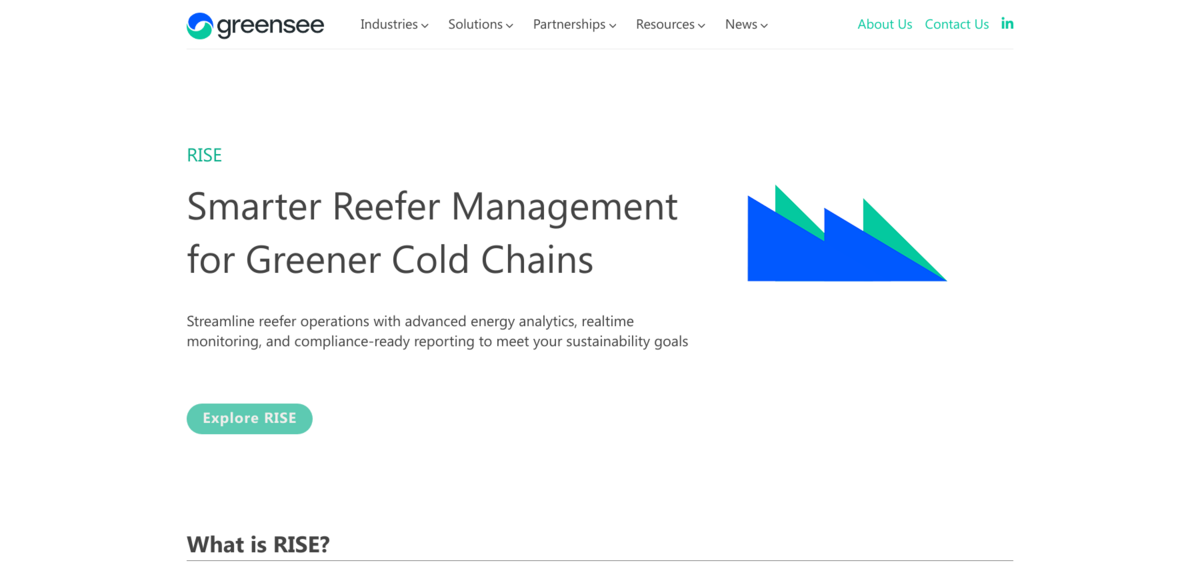What Is the Project?
The Greensee project is all about “Sustainability with impact” – a solid initiative that transforms maritime data into useful information and actionable insight. At its core, Greensee is committed to optimizing routes, tracking shipments, and ensuring the energy efficiency of reefers. With an impressive suite of solutions, including TRACE, GEOCE, RISE, and VISTA, the project focuses on converting raw data collected by sensors into dynamic strategic tools for shipping lines, LSPs, terminals, and carriers. Greensee stands as a reliable partner in the maritime industry, delivering the very tools that help in reducing CO₂ emissions, improving fleet management, and enhancing overall efficiency in global shipping operations… It’s clear that the project is built on cutting-edge container IoT data, providing actionable insight that major players in the maritime field can depend on.
Main Benefit
The benefits realized through Greensee’s integration with Bluepulse solutions are nothing short of transformative – with measurable improvements that include:
- Offering predictive maintenance insight for reefers that cuts costs by 10 to 15%.
- Decreasing downtime and quality issues by 20 to 25%.
- Enhancing profitability for shipping lines by 15 to 20 million dollars per year.
- Facilitating reefers’ energy prediction both on boats and in ports, which helps in planning for renewable energy sources.
- Targeting key players such as the world’s 10 largest shipping lines (e.g., CMA/CGM, Maersk, MSC, Hapag Lloyd, COSCO) and the 100 largest maritime ports (including prominent names in Taiwan, Singapore, Rotterdam, etc.).
Industry Applications and Evolution
The project spans various industries, addressing the specific needs of shippers, LSPs, terminals, and carriers. For shippers, it offers comprehensive solutions such as route optimization, shipment visibility insights – and sometimes even port performance optimization – that ensure every move is calculated and results in lower emissions. LSPs benefit from sustainable routing solutions that provide real-time shipment tracking, while terminals enjoy extensive analytics dashboards and geospatial insights for energy optimization. Carriers are not left out; the same VISTA and GEOCE functionalities extend to decarbonized route planning and real-time vessel tracking, ensuring a holistic approach to sustainability across maritime operations… All these diverse applications underline a transformative shift in how data is harnessed for improved efficiency and environmental stewardship.
The Role of Innovative Solutions
Central to the project’s promise are its innovative solutions. TRACE optimizes routes, ensuring CO₂ emissions are minimized step by step. GEOCE is all about real-time asset tracking – turning mountains of data into clear, actionable insights. RISE is tailored to streamline energy use for reefers, a crucial aspect when predictive maintenance and energy budgeting are concerned. Lastly, VISTA brings vessel visibility and port efficiency into sharp focus, serving as a versatile dashboard and a critical tool in terminal operations. These solutions are not just technological advancements; they are integral components of a dynamic strategy aimed at transforming operations for the better, making shipping more agile and prepared for the future.
Partnerships and Expanded Ecosystems
Collaboration plays a key role in the success of the Greensee project. The project actively invites industry stakeholders to become partners and join the broader Greensee ecosystem. This collaborative approach helps architects and users alike benefit from shared experiences in regulatory compliance, technology integration, and customer success stories. Detailed resources, including documentation and API references, further empower users to dive deep into the technology while staying informed about relevant maritime regulations and compliance standards. It is an environment that nurtures both growth and innovation, emphasizing how modern digitalization of maritime shipments can create sustainable and cost-effective operations.
Blending Digitalization With Sustainability
As digitalization continues to reshape maritime transportation, the Greensee project demonstrates how robust digital solutions can align with sustainability goals. The deployment of sensors and the continuous collection of data have become a reality across the board. Platforms like Bluepulse add tremendous value by processing container IoT data and transforming it into actionable insights that drive decision-making. This seamless blend of technology and sustainability means that natural resources are better managed, operational risks decrease, and overall efficiency sees a significant boost. In an industry where every fraction of improvement counts, these digital advancements contribute to a proactive strategy that addresses both operational and environmental challenges.
Project Impact
- SDG 7 – Affordable and Clean Energy: By predicting reefers’ energy needs and optimizing energy use, the project supports a transition to renewable energy sources.
- SDG 9 – Industry, Innovation, and Infrastructure: By digitizing maritime data and deploying advanced IoT solutions, the project fosters resilient infrastructure and innovation in shipping logistics.
- SDG 13 – Climate Action: With its focus on reducing CO₂ emissions through decarbonized route planning and efficient energy management, the project contributes directly to combating climate change.
- SDG 11 – Sustainable Cities and Communities: Enhanced port performance and terminal analytics support urban areas dependent on maritime trade.
- SDG 12 – Responsible Consumption and Production: The project’s efficient use of resources ensures that shipping operations become more environmentally conscious.
Looking Ahead: Future of Maritime Innovation
In the coming years, the Greensee project, powered by Bluepulse insights, is set to further revolutionize maritime shipping. By continuing to fine-tune predictive maintenance for reefers and improve vessel visibility across all segments of the industry, the project not only aims to sustain current operations but also to spark a broader shift toward smarter, digital-first maritime logistics. The dynamic integration of sensor data and advanced analytics ensures that as the industry grows, so does the emphasis on sustainable practices. Innovations such as real-time tracking, energy prediction, and enhanced port analytics pave the way for an operational revolution – one that promises increased profitability, reduced operational risk, and most importantly, a positive environmental impact. The natural flow of continuous data integration combined with adaptive digital platforms positions the industry at the cusp of a future where technology and sustainability work hand in hand.





















